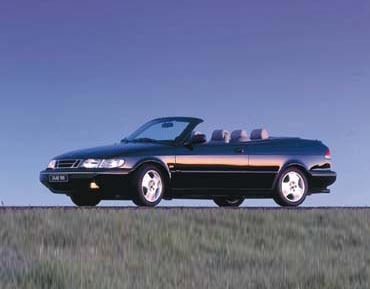1997 SAAB 900 SE TURBO CONVERTIBLE
 |
By Tom Hagin
SEE ALSO: Saab Buyer's Guide
SPECIFICATIONS
Manufacturer's Suggested Retail Price $ 40,995
Price As Tested $ 41,700
Engine Type Turbocharged 2.0 Liter I4 w/PFI*
Engine Size 121 cid/1985 cc
Horsepower 185 @ 5500 RPM
Torque (lb-ft) 194 @ 2100 RPM
Wheelbase/Width/Length 102.4"/67.4"/182.6"
Transmission Five-speed manual
Curb Weight 3213 Pounds
Fuel Capacity 18 gallons
Tires (F/R) 205/50ZR16
Brakes (F/R) Disc (ABS)/disc (ABS)
Drive Train Front-engine/front-wheel-drive
Vehicle Type Four-passenger/two-door
Domestic Content Three percent
Coefficient of Drag (Cd.) 0.34
PERFORMANCE
EPA Economy, miles per gallon
city/highway/average 20/27/23
0-60 MPH 7 seconds
1/4 Mile (E.T.) 16 seconds @ 90.5 mph
Top-speed 142 mph
* Port fuel injection
After 50 years Saab continues to build distinct cars for unique buyers. This week's tester, the '97 Saab 900 convertible, is special in that it has a back seat big enough for two, and its trunk space is large, something unheard of in a ragtop. Saabs are unique but practical.
Saab's 900 series consists of two trim levels, S and SE, in coupe, sedan or this week's test vehicle, the convertible. When it comes in turbo-form as our test car did, it's also a road rocket.
OUTSIDE - The 900 was all-new in 1994, but despite its recent changes, its look continues to be pure Saab. The high cowl and thick front and rear pillars restrict outward visibility, but only with the top up. Lowering the roof is simple, with two latches at the top of the windshield header, and a one-button electric switch for the top and windows. The snug-fitting top is fully insulated and consists of an outer layer covering a waterproof rubber layer and a cotton layer inside. There is also an additional fabric headliner designed to trap about an inch of air space to protect against extreme temperatures. It features a glass rear window, and a rear window defroster is standard. Saab's "Viking Aero" alloy wheels for 1997 are new and include visible lug nuts which were previously hidden behind a center cap.
INSIDE - The familiar upright seats and dashboard that are Saab trademarks remain, as does the ignition switch mounted on the console between the seats. We loved its "Black Panel" feature, wherein the driver can turn off all dashboard lights at night, save for the speedometer, which reduces glare. The well that the top folds into is a design masterpiece. It's made of flexible fabric and can be snapped up and out of the way, revealing a rear seat pass-through which enables long items to be stowed inside. Standard equipment on all 900 SE models includes automatic climate control, eight-way power front seats with driver's side memory, leather upholstery, glass sunroof, a trip computer, and a 160-watt, AM/FM cassette stereo with eight speakers. A trunk-mounted six-disc CD changer is standard on SE convertibles.
ON THE ROAD - The Saab convertible is available with one of three engines, and each makes the 900 a different car. The first, a 150 horsepower four cylinder, comes standard with the S model, and gives impressive, affordable acceleration. The second, a V6 with 170 horsepower, is smooth and comfortable, and makes the car a fine Grand Tourer. It is optional on the SE sedan and convertible. Our tester came with the turbocharged four-cylinder engine, two liters in displacement, with 185 horsepower and 195 lb-ft of torque. This year, it features a smaller, more responsive turbocharger, new intake and exhaust systems, twin balance shafts for smoothness, and Saab's excellent Trionic engine management system. As expected, power comes on in a rush when the turbo kicks in, and with so much power going to its front-wheel-drive layout, torque steer can become a problem. To counter this, the Trionic system is programmed to lessen torque in first and second gear, which helps things somewhat. The standard five-speed manual transmission has always had a rather vague shifting linkage, but this year, a redesign of the linkage has helped. A four-speed automatic transmission is optional.
BEHIND THE WHEEL - The 900 is built with some help from General Motors. Opel, the German G.M. subsidiary, contributes the rear suspension pieces, while Saab tosses in the MacPherson strut front setup. The partnership produced a vehicle that is vastly stiffer than before, and has continued to be updated since its debut in 1994. The ride of our Turbo model was stiff and taut, and its handling excellent. A full load aboard didn't faze it, save for a few rough jounces over huge highway expansion joints. Its speed-sensitive rack-and-pinion steering system is responsive, though a bit on the heavy side. This year Saab has increased the diameter of the brakes and repositioned the brake pads of the entire 900 series line, and has combined them with its proven anti-lock braking system, or ABS.
SAFETY - Dual airbags, side-impact beams and ABS are standard.
OPTIONS - Our tester came only with special paint at $180 extra.


